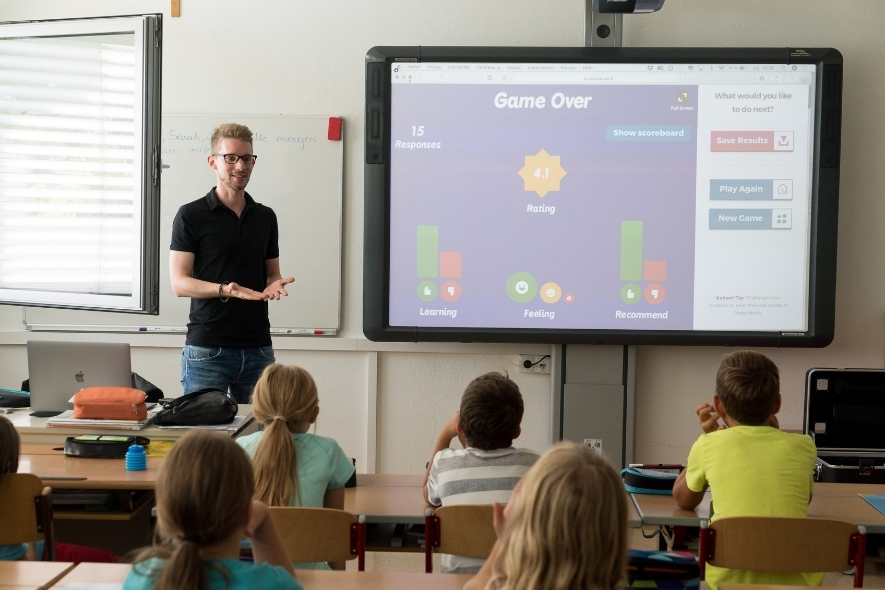As educators, we have to constantly innovate to adapt our style to the ever-changing needs of new students. New teaching techniques are always emerging, so, whether you’ve been an educator for 40 years or just 4 months, you should always be looking for ways to improve your teaching quality.
Students need to learn a wide range of abilities, therefore, it is extremely important that teachers have a wide range of strategies to ensure that all students are able to achieve their best possible results.
In this article, you’ll find 7 ways that teachers can improve their lessons.
Use ICT tools and digital game-based learning

As the world is becoming more and more digitalized, even very young students are now able to use technology proficiently. That is why including ICT tools in your lessons makes them more relevant and fun for your students and, as a consequence, it helps them to achieve better learning outcomes.
Apart from the popular quiz-making app Kahoot, great for competitive students who will do their best to answer the quickest and get the most points, there are thousands of great online tools for teachers to use on the internet. For instance, the app Study Blue is also really useful as it allows teachers to create flashcards and study materials for their students and students can also use this themselves during their revision.
Using digital game-based learning, such as Minecraft in your class, is not impossible once you have an intermediate level of computer proficiency, and not only does it help your students to fully engage in the learning process but also enhances their creativity and team-working.
-> If you struggle with using technology in your lessons and want to improve these skills, find out 15 Online Apps & Tools for Teaching (Free of Charge).
Differentiate between students

While your students will most likely be the same age, it is very unlikely that they are all at the same level. Therefore, it is important that you differentiate between students and provide a range of activities that will challenge the more skilled members of the class but that the less talented will still be able to take part in too.
A way to ensure that all members of the class are being sufficiently challenged is to introduce an ‘extension activity’ for the more gifted pupils who might finish an activity much faster than the other students. This would include more questions about the topic or a final more difficult exercise to be solved only once the student has completed the minimum compulsory activity.
In addition, some learning styles suit some learners better too. Some students may be visual learners and therefore might learn better by watching a video or a mind map, whereas other students may be reading/writing learners and therefore find reading and taking notes the easiest way to learn.
Therefore, make sure that you include a wide range of activities so that each lesson caters to different learning styles.
-> If you wish to discover more on the different learning styles, check out the blog article “Learning Styles > Fact or Fiction?“
Use the flipped classroom model
The flipped classroom model is a technique that we really encourage teachers to use. By implementing this methodology, students complete readings or watch videos to grasp the content of a subject at home and complete activities, which would often be set as homework, in the classroom. This results not only in an increase in student-teacher interaction, with the student at the centre of the lesson but also in increased interaction among students, that are encouraged to actively collaborate during the class. The flipped learning model also allows teachers to help those students who struggle to understand the concepts more since the activities take place in class time so it is easier to see which students have grasped it and which haven’t.
-> Want to find out more about the flipped classroom model? Read our blog article “Flipped Classroom: Everything You Always Wanted to Know“
Encourage cooperative learning
Cooperative learning is when students work together in groups in order to complete an assigned task. Cooperative learning is important as students have to rely on one another in order to achieve the outcome. It also makes students develop teamwork skills which are also extremely useful for life outside of school.
Lots of students dislike the idea of group work as they fear that they will be put in a group where some pupils won’t do as much work as others. Therefore, if students are working in groups, it is a good idea to make sure that every member of the group has been assigned a specific role, to ensure that every learner pulls their weight.
-> Discover Five Strategies to use Cooperative Learning in Your Classroom
Communicate with colleagues
A great way less experienced teachers can improve their lessons is to speak to more experienced colleagues to discuss good practices and new teaching techniques which you may not have heard about. A more experienced teacher can also be a very important source of support and can give you good advice about a variety of issues which you may come across as a teacher since they will have already experienced and managed to overcome the same issues.

Communicate with parents
Just as communicating with fellow teachers is extremely important, it is also important to ensure you communicate with students’ parents. Parents play an absolutely vital role in their children’s education as they can supervise and enforce students completing their homework and studying at home.
In addition, it is also important to communicate with parents regarding behavior management. It can be very confusing for a child if their behavior is being managed in different ways at home and at school. Therefore, teachers and parents can also discuss the best ways to manage any difficult behavior and come up with a unified approach.
A good way to facilitate this communication between parents and teachers is to have a parent-teacher evening to discuss each individual child’s progress.
Create a welcoming environment

In teaching, you meet and teach students from a wide range of different socio-economic, cultural, and social backgrounds. It is extremely important that regardless of their gender, sexuality, or background, all students feel comfortable in your classroom and feel comfortable to give their opinion.
There are many ways that you can promote diversity within the classroom for example by looking at the curriculum and ensuring that you are teaching students about a wide range of historical events involving people from different ethnicities and cultural backgrounds. You should also ensure that you confront any discrimination whenever you hear it in the classroom or corridors. Finally, you should also make sure you use language that promotes diversity or deconstructs stereotypes, for instance, if you hear phrases such as ‘man up’ which reinforces the stereotype that all men must be strong and cannot talk about their feelings, it would be a good idea to discuss it with your students.
-> Do you want to learn more about how to create an inclusive classroom environment for students from diverse backgrounds? Check out our course ‘Managing a Diverse Classroom: Facing Upcoming Challenges‘
Conclusion
Regardless of age or experience, all teachers can improve their teaching styles. In order to do so, teachers need to make sure that their lessons remain relevant, by implementing the latest teaching techniques or tools- teachers can find out the latest trends and techniques by speaking to other members of the profession. Teachers also need to ensure that they communicate sufficiently with parents so that they work together to provide the best possible education for the child concerned. Indeed, the best way to create an inclusive learning environment for students from any background is to talk with them, get to know them, and care about them, for instance, integrating their hobbies in the classroom is usually a good way to increase their interest.
Are there any other ways that you think teachers are able to improve their classes? Share them with us in the comments below!

Very impressive teaching aids or tools or smart ways to in hence your teaching skills
this is a really really great work. it was best I saw